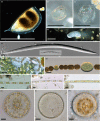Paleolimnology and resurrection ecology: The future of reconstructing the past
- PMID: 29302271
- PMCID: PMC5748527
- DOI: 10.1111/eva.12556
Paleolimnology and resurrection ecology: The future of reconstructing the past
Abstract
Paleolimnologists have utilized lake sediment records to understand historical lake and landscape development, timing and magnitude of environmental change at lake, watershed, regional and global scales, and as historical datasets to target watershed and lake management. Resurrection ecologists have long recognized lake sediments as sources of viable propagules ("seed or egg banks") with which to explore questions of community ecology, ecological response, and evolutionary ecology. Most researchers consider Daphnia as the primary model organism in these efforts, but many other aquatic biota, from viruses to macrophytes, similarly produce viable propagules that are incorporated in the sediment record but have been underutilized in resurrection ecology. The common goals shared by these two disciplines have led to mutualistic and synergistic collaborations-a development that must be encouraged to expand. We give an overview of the achievements of paleolimnology and the reconstruction of environmental history of lakes, review the untapped diversity of aquatic organisms that produce dormant propagules, compare Daphnia as a model of resurrection ecology with other organisms amenable to resurrection studies, especially diatoms, and consider new research directions that represent the nexus of these two fields.
Keywords: community ecology; life‐history evolution; natural selection and contemporary evolution; species interactions.
Figures

References
-
- Agrawal, S. C. , & Singh, V. (2000). Vegetative survival, akinete formation and germination in three blue‐green algae and one green alga in relation to light intensity, temperature, heat shock and UV exposure. Folia Microbiologica, 45, 439–446. - PubMed
-
- Alekseev, V. R. , De Stasio, B. , & Gilbert, J. J. (Eds.) (2007). Diapause in aquatic invertebrates. Theory and human use. Dordrecht, The Netherlands: Springer.
-
- An, S. M. , Kim, S. Y. , Noh, J. H. , & Yang, E. C. (2016). Complete mitochondrial genome of Skeletonema marinoi (Mediophyceae, Bacillariophyta), a clonal chain forming diatom in the west coast of Korea. Mitochondrial DNA Part B, 1, 549–550. - PubMed
-
- Anderson, N. J. (2014). Landscape disturbance and lake response: Temporal and spatial perspectives. Freshwater Reviews, 7, 77–120.
Publication types
LinkOut - more resources
Full Text Sources
Other Literature Sources
Miscellaneous

